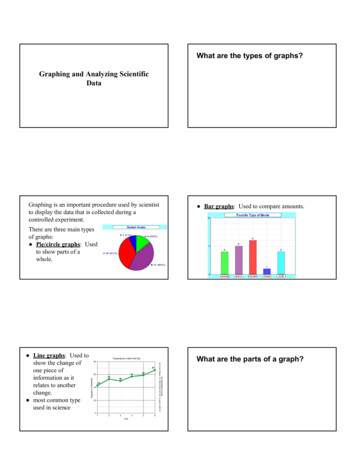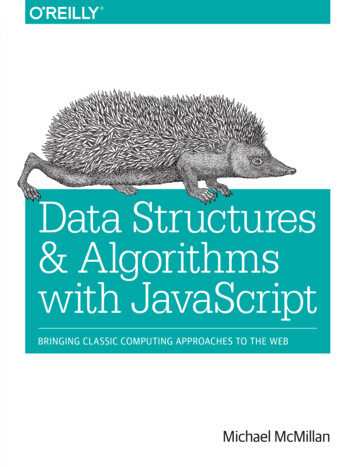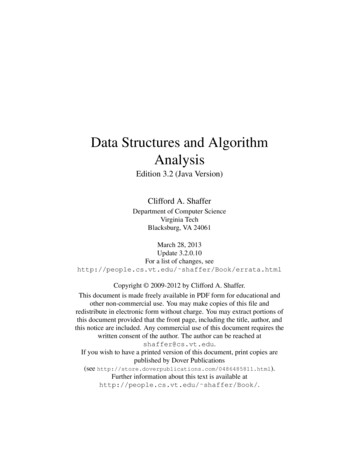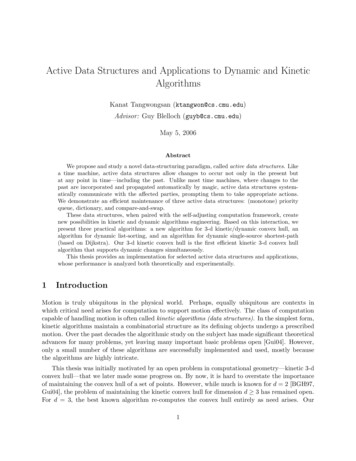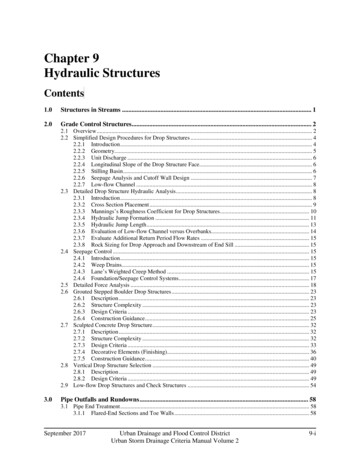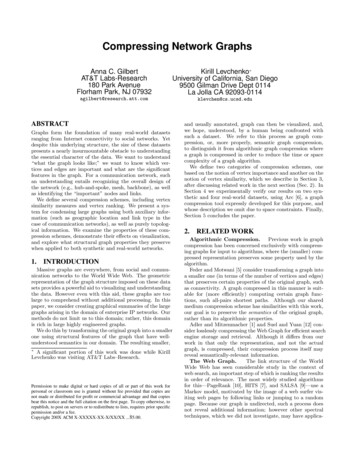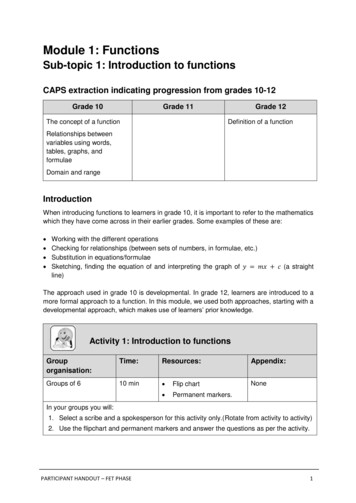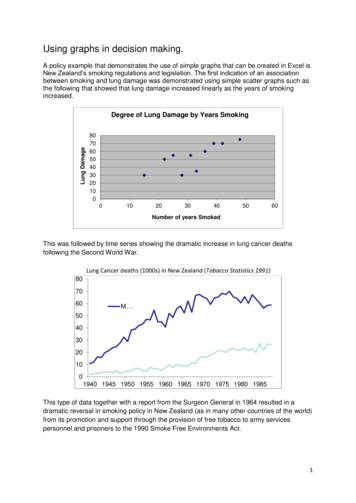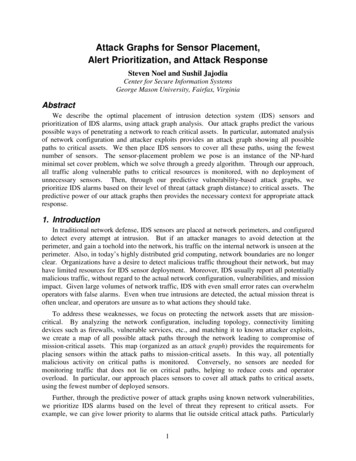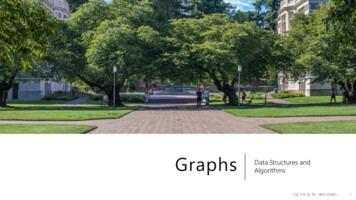
Transcription
GraphsData Structures andAlgorithmsCSE 373 SU 18 – BEN JONES1
WarmupDiscuss with your neighbors:Come up with as many kinds of relational data as you can (data that can be representedwith a graph).CSE 373 SU 18 – BEN JONES2
AnnouncementsProject 2 Due on FridayNext individual HW assignment assigned tonight, due next Wednesday- Two problems – merge sort and graph practiceSign up for Project 3 partners by Thursday night!I am gone tonight through Tuesday. Robbie will be lecturing again. No instructor office hours tomorrow orTuesday next week.CSE 373 SU 18 – BEN JONES3
Graph: Formal DefinitionA graph is defined by a pair of sets G (V, E) where G- V is a set of vertices- A vertex or “node” is a data entityHV { A, B, C, D, E, F, G, H }- E is a set of edgesF- An edge is a connection between two verticesAE { (A, B), (A, C), (A, D), (A, H),(C, B), (B, D), (D, E), (D, F),(F, G), (G, H)}DCBECSE 373 SP 18 - KASEY CHAMPION4
Graph VocabularyUndirected Graph:Graph DirectionA- Undirected graph – edges have no direction and are two-wayV { A, B, C }E { (A, B), (B, C) } inferred (B, A) and (C,B)- Directed graphs – edges have direction and are thus one-wayV { A, B, C }E { (A, B), (B, C), (C, B) }Undirected Graph:BADegree of a Vertex- Degree – the number of edges containing that vertexA : 1, B : 1, C : 1- In-degree – the number of directed edges that point to a vertexA : 0, B : 2, C : 1- Out-degree – the number of directed edges that start at a vertexA : 1, B : 1, C : 1BCCCSE 373 SP 18 - KASEY CHAMPION5
Food for thoughtIs a graph valid if there exists a vertex with a degree of 0? YesBABAACCA has an “in degree” of 0Is this a valid graph?CB has an “out degree” of 0Are these valid?AC has both an “in degree”and an “out degree” of 0YupBAYes!BABCSureDCCSE 373 SP 18 - KASEY CHAMPION6
Graph VocabularySelf loop – an edge that starts and ends at the same vertexAParallel edges – two edges with the same start and end verticesABSimple graph – a graph with no self-loops and no parallel edgesComplete graph – a graph with edges between every pair of verticesCSE 373 SP 18 - KASEY CHAMPION7
For simple, undirected graphs What is the fewest number of edges a graph with n vertices can have?0What is the sum of the degrees of all vertices in a graph? (in terms of V and E )2 E What is the maximum number of edges a graph with n vertices can have?n(n-1)/2 𝑂 𝑛2 - (the complete graph on n vertices 𝐾𝑛 )CSE 373 SU 18 – BEN JONES8
Representing GraphsDiscuss with your neighbor: How would you implement a non-weighted, undirected graph?Assume there are n vertices, and those vertices are numbered 0, 1, 2, , n-1.As an example:04156G (V, E)23V {0,1,2,3,4,5,6}, E { (0,1), (0,2), (1,3), (3,5), (4,5) }CSE 373 SU 18 – BEN JONES9
Representing Graphs0641253CSE 373 SU 18 – BEN JONES10
Adjacency Matrix0416523A matrix is a table of numbers, a[u][v].In an adjacency matrix a[u][v] is 1 if there is an edge (u,v),and 0 otherwise.Can represent both undirected and directed graphsCan represent self-loops and parallel edges (interpret asthe # of edges between two verticesTime Complexity ( V n, E m):Add Edge: O(1)Remove Edge: O(1)Check edge exists from (u,v): O(1)Get neighbors of u (out): O(n)Get neighbors of u (in): O(n)Space 400000105000110060000000𝑂(𝑛2 )CSE 373 SU 18 – BEN JONES11
SparsityA Dense Graph is a graph with many edges 𝐸 𝑉2A Sparse Graph is a graph with few edges 𝐸 𝑉 Adjacency Matrices are very wasteful of space for spare graphs – they are almost all 0s!How could we save space?CSE 373 SU 18 – BEN JONES12
Adjacency List0641253An array where the u’th element contains a list of neighbors of u.Can represent both undirected and directed graphsIn the directed case, put the out neighbors (a[u] has v for all (u,v) in E)01 210 3Can represent self-loops and parallel edges (repeat neighbor)20 3Time Complexity ( V n, E m):Add Edge: O(1)Remove Edge: O( min(n, m) )Check edge exists from (u,v): O( min(n, m) )Get neighbors of u (out): O(n)Get neighbors of u (in): O(n m)31 2 54553 46Space Complexity: O(n m)CSE 373 SU 18 – BEN JONES13
Graph VocabularyWeighted Graph – a graph with numeric weights associated with each edge3AB0C-5D- can be directed or undirected- weights can be negative, positive or 0- common to specify “only non-negative edge weights”, or “only positive edge weights”- denoted e (u, v, w) or sometimes e ((u,v), w)- Weights often carry meaning such as “distance”, (e.g. driving time between cities)CSE 373 SU 18 – BEN JONES14
Representing Weighted GraphsAdjacency Matrix – You can make the value of at each element the weight of the edge- In an int array (int[]) you can’t distinguish between 0 weight edge and no edge- Solution 1 – You know ahead of time that 0 weight (or negative weight) edgesdo not exist and use that to represent no edge- Solution 2 (Java) – Use an Integer array (Integer[]) – have null represent no edgeAdjacency list – Store pairs (neighbor, edge weight)CSE 373 SU 18 – BEN JONES15
Storing Data In GraphsWe often have data associated with vertices and edgesVertex Data Examples:- Facebook: Name, Age, Birthday, Hometown, Likes- Google Maps: City name, elevation, hours of operation- Internet: Page title, page contents, date last modifiedEdge Data Examples:- Facebook: Date friendship was made, friend vs. acquaintance, etc.- Google Maps: Length of road, speed limitCSE 373 SU 18 – BEN JONES16
Storing Data in GraphsWe could have a Graph V, E where V is a data type for Vertices and E is one for EdgesAdjacency Matrix: E[][] – now each entry has a pointer to edge data, or null if that edge isnot in the graphAdjacency List: E[] – the neighbor lists are now a list of edgesBoth: Maintain a list V[] of verticesAlternative Adjacency List: V[] just a list of vertices, where each vertex contains within it a listof (outgoing) edges.CSE 373 SU 18 – BEN JONES17
Arrays HashTablesWhen we analyze and describe graph algorithms, for simplicity we assume that each vertex has aunique identity 0, 1, 2, n-1.Accesses in Adjacency Matrices and getting an adjacency list are both worst case O(1) for arrays.In reality, we often don’t have unique sequential integers for each vertex. In a real graphimplementation, we often use HashMaps or HashSets.This would get us average case O(1), but worst case O(n). This is bad in analysis, but fine in practice.An adjacency list that stores references to the actual vertex objects can avoid repeated table lookups.We could always use a hash table to give unique integer IDs to every element, incurring an O(n)worst case, but O(1) average case overhead before each call (which can save our worst case analysisfor any O(n) or slower algorithm), but we don’t usually bother to.CSE 373 SU 18 – BEN JONES18
Graph VocabularyPath – A sequence of connected verticesABCD(Directed) Path – A path in a directed graph must follow the direction of the edgesABCDPath Length (unweighted) – The number of edges in a path- (A,B,C,D) has length 3.Simple Path – A path that doesn’t repeat vertices (except maybe first last)Cycle – A path that starts and ends at the same vertex (of length at least 1)CSE 373 SU 18 – BEN JONES19
Graph VocabularyConnected Graph – A graph that has a path from every vertex to every other vertex (i.e.every vertex is reachable from every other vertex.Strongly Connected Graph – A directed graph that is connected (note the direction of theedges!)Weakly Connected Graph – A directed graph that is connected when interpreted asundirected. (Note all strongly connected graphs are also weakly connected)CSE 373 SU 18 – BEN JONES20
Paths and ReachabilityVery common questions:- Is there a path between two vertices? (Can I drive from Seattle to LA?)- What is the length of the shortest path between two vertices? (How long will it take?)Less common, but still important:What is the longest path in a graph?-In general a “hard” problem7 degrees of Kevin BaconLength of this path is called the “diameter” of a graphCSE 373 SU 18 – BEN JONES21
TreesA tree is a connected, acyclic graph.An a tree there exist exactly one path between every pair of vertices.A graph consisting of several disconnected trees is called a forest.The trees we have seen so far have been rooted trees – interpret one vertex as the root, andits neighbors are now children, and the root of their own subtrees.How many edges does a tree with n vertices have?n-1CSE 373 SU 18 – BEN JONES22
DAGsDAG stands for Directed, Acyclic, GraphThis is the directed graph analog of a forest.The trees we have made so far in this class have been implemented as weakly connectedDAGs.Can be used to represent dependencies: i.e. A must be completed before either B or C, andboth B and C must be completed before D. Scheduling these tasks is called topological sort.CSE 373 SU 18 – BEN JONES23
SubgraphsTake a graph, and delete vertices and edges so you still have a graph.The remaining red vertices and edges form a subgraph.Formally: 𝐺′ 𝑉 ′ , 𝐸 ′ 𝐺 𝑉, 𝐸 𝑉 ′ 𝑉 and 𝐸′ 𝐸 𝑎𝑛𝑑 𝐺′ 𝑖𝑠 𝑎 𝑔𝑟𝑎𝑝ℎCSE 373 SU 18 – BEN JONES24
Interesting SubgraphsCliques- A clique is a complete subgraph- A maximal clique is a clique that you could not add any more vertices to and still have a clique. This is distinctfrom the maximum clique, which is the largest clique in a graph.CSE 373 SU 18 – BEN JONES25
Interesting SubgraphsConnected Components- A connected component is a maximal, connected subgraph- In directed graphs, you have two kinds: strongly connected, and weakly connected:CSE 373 SU 18 – BEN JONES26
Interesting SubgraphsA Spanning Tree is a subgraph that is both a tree and includes every vertex (it spans thegraph).Every connected graph has at least one spanning tree. They are like skeletons of the graph.An important problem is finding the minimum spanning tree. We will learn 2 algorithms forthis. It is useful for optimization tasks (e.g. minimum cost to build a road network).CSE 373 SU 18 – BEN JONES27
Other interesting Graph Problems- Circuits – paths or cycles that touch every vertex- Reductions – Everything we’ve seen so far in this class can be represented as a graph – alot of other problems can too! Graphs can solve many problems.CSE 373 SU 18 – BEN JONES28
- Directed graphs -edges have direction and are thus one-way Degree of a Vertex - Degree-the number of edges containing that vertex A : 1, B : 1, C : 1 - In-degree-the number of directed edges that point to a vertex A : 0, B : 2, C : 1 - Out-degree-the number of directed edges that start at a vertex A : 1, B : 1, C : 1
